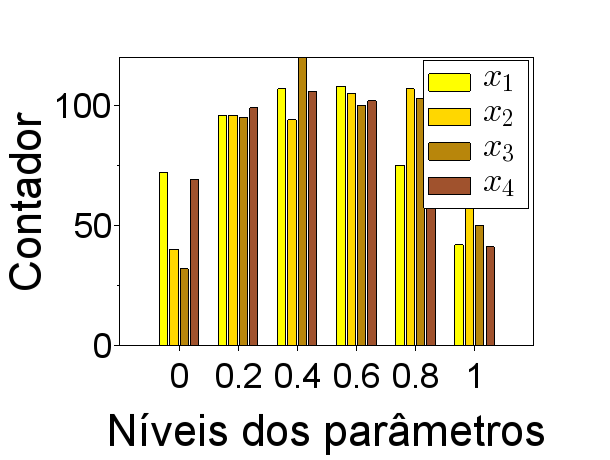IPSAL: Implementation of Morris Elementary Effects Method for Vector Output
DOI:
https://doi.org/10.14295/vetor.v34i2.18214Keywords:
Elementary Effect, Sensitivity Analysis, Morris Method, IPSAL, ScilabAbstract
Sensitivity analysis is essential for understanding the impact of a model's inputs on its output. The study identifies which inputs are influential in a model. The assessment of a model's sensitivity can be analyzed locally, only around a nominal point in the input sample space, or globally, considering changes within the entire input mutability space. The Morris method is a all-at-a-time, one-input-at-a-time, global analysis method. It generates sets of model inputs using a random sampling strategy, which is achieved through so-called trajectory matrices. The Morris method uses the mean and standard deviation of elementary effects to infer the model's sensitivity to an input, and possible correlations between them. It is in this sense that the objective of this work is to present the Morris module in the Inverse Problem and Sensitivity Analysis Library developed in Scilab, applied in a practical case.Downloads
References
E. Borgonovo e E. Plischke, “Sensitivity analysis: A review of recent advances,” European Journal of Operational Research, vol. 248, no. 3, pp. 869–887, 2016. Disponível em: https://doi.org/10.1016/j.ejor.2015.06.032
A. Saltelli, K. Aleksankina, W. Becker, P. Fennell, F. Ferretti, N. Holst, S. Li, e Q. Wu, “Why so many published sensitivity analyses are false: A systematic review of sensitivity analysis practices,” Environmental Modelling & Software, vol. 114, pp. 29–39, 2019. Disponível em: https://doi.org/10.1016/j.envsoft.2019.01.012
F. F. Ferreira, A. J. da Silva Neto, G. B. Lyra, e S. P. de Queiroz, “Van Genuchten sensitivity analysis by Morris method,” Anais do XXIII ENMC – Encontro Nacional de Modelagem Computacional e XI ECTM – Encontro de Ciência e Tecnologia de Materiais, 2020.
S. Razavi, A. J. Jakeman, A. Saltelli, C. Prieur, B. Iooss, E. Borgonovo, E. Plischke, S. L. Piano, T. Iwanaga, W. E. Becker, S. Tarantola, J. H. A. Guillaume, J. D. Jakeman, H. V. Gupta, N. Melillo, G. Rabitti, V. Chabridon, Q. Duan, e H. R. Maier, “The future of sensitivity analysis: An essential discipline for systems modeling and policy support,” Environmental Modelling & Software, vol. 137, p. 104954, 2020. Disponível em: https://doi.org/10.1016/j.envsoft.2020.104954
F. F. Ferreira, T. H. Horita, G. B. Lyra, e F. Gonçalves, “Análise de sensibilidade e otimização do modelo de Thornthwaite and Mather adapatado para simulação de culturas agrícolas pelo método de Levenberg-Marquardt com restrições,” Revista Mundi Engenharia, Tecnologia e Gestão, vol. 8, no. 1, pp. 1–17, 2023.
A. Jankovic, G. Chaudhary, e F. Goia, “Designing the design of experiments (DOE) – an investigation on the influence of different factorial designs on the characterization of complex systems,” Energy and Buildings, vol. 250, p. 111298, 2021. Disponível em: https://doi.org/10.1016/j.enbuild.2021.111298
F. Campolongo, A. Saltelli, e J. Cariboni, “From screening to quantitative sensitivity analysis. a unified approach,” Computer Physics Communications, vol. 182, no. 4, pp. 978–988, 2011. Disponível em: https://doi.org/10.1016/j.cpc.2010.12.039
S. Razavi e H. V. Gupta, “What do we mean by sensitivity analysis? the need for comprehensivecharacterization of “global” sensitivity in earth and environmental systems models,” Water Resources Research, vol. 51, no. 5, pp. 3070–3092, 2015. Disponível em: https://doi.org/10.1002/2014WR016527
F. Pianosi, K. Beven, J. Freer, J. W. Hall, J. Rougier, D. B. Stephenson, e T. Wagener, “Sensitivity analysis of environmental models: A systematic review with practical workflow,” Environmental Modelling & Software, vol. 79, pp. 214–232, 2016. Disponível em: https://doi.org/10.1016/j.envsoft.2016.02.008
Q. Ge e M. Menendez, “Extending morris method for qualitative global sensitivity analysis of models with dependent inputs,” Reliability Engineering & System Safety, vol. 162, pp. 28–39, 2017. Disponível em: https://doi.org/10.1016/j.ress.2017.01.010
F. Campolongo e R. Braddock, “The use of graph theory in the sensitivity analysis of the model output: a second order screening method,” Reliability Engineering & System Safety, vol. 64, no. 1, pp. 1–12, 1999. Disponível em: https://doi.org/10.1016/S0951-8320(98)00008-8
A. Franczyk, “Using the Morris sensitivity analysis method to assess the importance of input variables on time-reversal imaging of seismic sources,” Acta Geophysica, vol. 67, p. 1525–1533, 2019. Disponível em: https://doi.org/10.1007/s11600-019-00356-5
M. Ruano, J. Ribes, A. Seco, e J. Ferrer, “An improved sampling strategy based on trajectory design for application of the Morris method to systems with many input factors,” Environmental Modelling & Software, vol. 37, pp. 103–109, 2012. Disponível em: https://doi.org/10.1016/j.envsoft.2012.03.008
D. King e B. Perera, “Morris method of sensitivity analysis applied to assess the importance of input variables on urban water supply yield – a case study,” Journal of Hydrology, vol. 477, pp. 17–32, 2013. Disponível em: https://doi.org/10.1016/j.jhydrol.2012.10.017
A. F. da Silva Oliveira, F. F. Ferreira, F. Gonçalves, A. E. Junior, L. F. A. Borges, T. H. Horita, e G. B. Lyra, “Ipsal: Implementation of the morris elementary effects method,” Anais do XXIII ENMC – Encontro Nacional de Modelagem Computacional e XI ECTM – Encontro de Ciência e Tecnologia de Materiais, 2023.
F. Campolongo, J. Cariboni, e A. Saltelli, “An effective screening design for sensitivity analysis of large models,” Environmental Modelling & Software, vol. 22, no. 10, pp. 1509–1518, 2007. Disponível em: https://doi.org/10.1016/j.envsoft.2006.10.004
F. FAOSTAT, “Organização das nações unidas para alimentação e agricultura (FAO),” Bancos de dados estatísticos da FAO. Dados de agricultura, 2000.
















